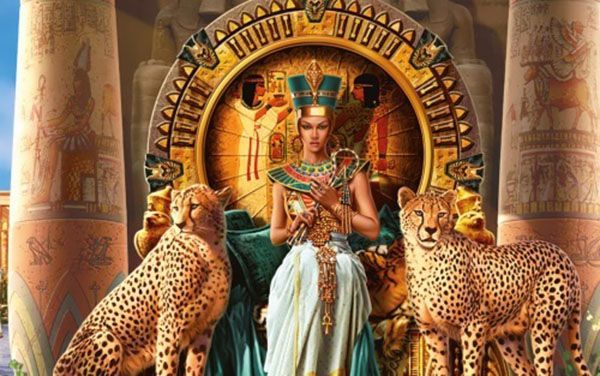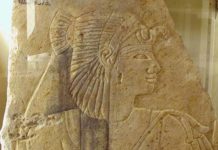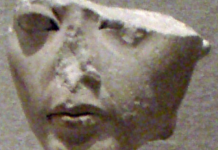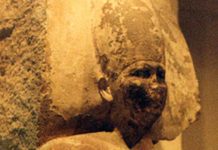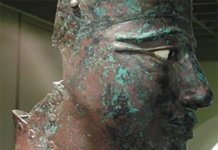The Egyptian queen bore Julius Caesar an illegitimate son in 47 BC, appropriately naming him Caesarion to demonstrate his relationship to Caesar. The boy who would have been a threat to Octavian met his death shortly after the suicides of his mother and step-father, Mark Antony in 30 BC. Cleopatra and Antony had three children, twins – Cleopatra Selene, and Alexander Helios (born 40 BC), and the younger son, Ptolemy Philadelphus (born 36 BC).
Octavia Raises Cleopatra’s Orphaned Children
Following Octavian’s invasion the orphaned children were taken to Rome to be cared for by Antony’s first wife, Octavia Minor – who was Octavian’s younger sister. The two boys who would have posed a threat to Octavian when they became of age may have been murdered later or died from illness, and both boys cease to be mentioned after 29 BC.
Princess Cleopatra survived, and by 20 BC Octavian – now styled Augustus arranged her marriage to King Juba II of Numidia in Africa. As the last surviving member of the Ptolemaic dynasty, the Emperor provided her with a huge dowry, and she became Rome’s ally. The newlyweds were given the territory of Mauretania – which comprises the coastline of modern Morocco and Algeria – a region which at that time needed Roman supervision.
Under Juba and Cleopatra the Kingdom of Mauretania flourished, and the Queen was proud of her Greco-Ptolemaic heritage. They had two children; Ptolemy (1 BC – 40 AD) and Drusilla (born about 8 BC). Drusilla became romanized and little is known of her life, or her fate. Cleopatra Selene died in 6 AD in her mid-forties.
Caligula Kills the Last Ptolemy
With the death of Juba II in 23 AD, Ptolemy succeeded as the last client King of Mauretania. He married a woman named Julia Urania – a member of the Royal Family of Emesa in modern day Syria. Urania bore Ptolemy a daughter in 38 AD, whom they named Drusilla – probably in honour of honour of Caligula’s sister, Livia Drusilla – who died at that very time. In 40 AD, Ptolemy met his end when he was invited to Rome by the tyrannical Caligula, who ordered Ptolemy’s assassination for no reason.
After her father’s death, Drusilla was raised by the Imperial family in Rome. This great-grandchild of Antony and Cleopatra was married to King Sohaemus of Emesa around 56 AD. Emesa was the leading kingdom in the Roman East, and it is through Drusilla that the bloodline may have continued.
The High Priests of Emesa
Drusilla bore Sohaemus a son named Gaius Julius Alexio, who ruled Emesa as King Alexio. Unfortunately, after Alexio the generations are not recorded sufficiently to accurately present a pedigree, and it is not known if the descendants of Alexio were the products of his union with Drusilla, or by another consort. A descendant of Alexio was Gaius Julius Bassianus – a High Priest in Emesa, who had two daughters, Julia Domna and Julia Maesa – who both married into the Imperial family.
Possible Roman Descendants of Cleopatra
Julia Domna married Emperor Septimus Severus, and became the mother of Emperors, Geta (ruled 209-211) and Caracalla (ruled 211-217). From the second Severan line, Julia Maesa was the grandmother of the two final Emperors of the dynasty, Elagabalus (ruled 218-222) and Alexander Severus (ruled 222-235).
After Septimus Severus, Caracalla had Geta murdered, and was later assassinated due to his brutal personality. Elagabalus demonstrated no respect for Roman religious or sexual traditions, and he and his mother were murdered by the mob – who disposed of his body in the Tiber. The reign of Alexander Severus enjoyed more prosperity, but the dynasty ended due to his inability to rule, and he was ultimately assassinated after alienating his legions on a military campaign to Germania aged twenty-six.
A third-century descendant of the Royal Family of Emesa was Zenobia – Queen of Palmyra, who led a remarkable rebellion against Roman authority by capturing Alexandria in the name of her ancestor, Cleopatra. Fortunately, she was spared and lived as a highly respected figure in Rome, and her beauty was just as legendary as that of Cleopatra, the last queen of Egypt.


